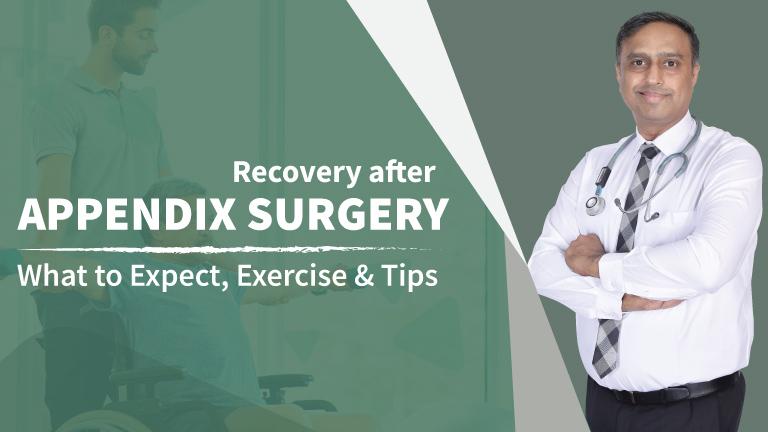Life After Appendix Removal Surgery
Life after an appendix removal surgery, also known as an appendectomy, is generally quite normal for most people. The appendix is a small, pouch-like organ located in the lower right abdomen. While its exact function is not well understood, it is not considered essential for survival, and its removal usually doesn’t have significant long-term impacts on overall health.
How long will it take to recover after appendix surgery (Appendectomy)?
Recovery time after appendix surgery can vary from person to person and the type of surgery done. The recovery period in the Laparoscopic surgery method is generally shorter compared to traditional open surgery. Here’s a general recovery time that you might expect after laparoscopic surgery:
- Hospital Stay: Most laparoscopic appendectomies are performed as outpatient procedures, which means you may be able to go home on the same day as the surgery if there are no complications. In some cases, a short hospital stay of a day or two might be recommended.
- Initial Days (1-2 Weeks): You may experience mild to moderate pain or discomfort around the incision sites and in the abdomen. This is normal and can usually be managed with prescribed pain medications.
- First Two Weeks: The small incisions made for the laparoscopic surgery will gradually heal over these weeks. You must keep the incision sites clean and take proper care of your wound.
- Weeks 2-4: Pain and discomfort should continue to improve during this time. You might still experience some soreness, but it should be less intense.
- Weeks 4 and Beyond: By the end of about four weeks, most people can resume their regular activities, including work and exercise. However, the full healing process may take a bit longer, and some mild discomfort or fatigue might persist.
Exercise you can perform at home after the appendix removal surgery
After a laparoscopic appendectomy, it’s important to start with gentle exercises that gradually increase your activity level while allowing your body to heal. Always follow your doctor’s recommendations and avoid any exercise that causes discomfort or pain. Here are some exercises you can perform at home during your recovery:
Deep Breathing Exercises:
- Sit or lie down comfortably.
- Take slow, deep breaths through your nose.
- Exhale slowly through your mouth.
- Deep breathing helps prevent lung congestion and improves lung function.
Knee Bends (Leg Lifts):
- Lie on your back, making your knees bent and feet flat on the floor.
- Gently lift one leg off the floor a few inches while keeping your knee slightly bent.
- Lower your leg back down.
- Alternate between legs.
- This exercise helps improve circulation and gently engages your abdominal muscles.
Shoulder Circles:
- Sit or stand comfortably with your arms relaxed at your sides.
- Slowly lift your shoulders towards your ears, then roll them backwards in a circular motion.
- Repeat in the opposite direction.
- This exercise helps alleviate shoulder discomfort caused by gas buildup during laparoscopic surgery.
Seated Marching:
- Sit straight on a chair and keep your feet flat on the floor.
- Lift one knee towards your chest and then lower it back down.
- Alternate between legs, as if you’re marching while seated.
- This exercise helps engage your leg muscles and improves circulation.
Gentle Walking:
- Start with short, slow walks around your home or in your yard.
- Gradually increase the duration and distance as you feel more comfortable.
- Walking promotes circulation, prevents blood clots, and aids in overall recovery.
Stretching:
- Perform gentle stretches for your arms, legs, and torso to prevent stiffness.
- Avoid any stretches that strain your abdominal area.
What are the Postoperative cares after Appendix removal surgery?
1. Incision Care: Keep the incision sites clean and dry. Follow your surgeon’s instructions on how to clean and dress the incisions, if required.
2. Pain Management: Take the prescribed pain medications as directed by your doctor and report any severe or worsening pain.
3. Activity and Movement: Start with gentle movements, such as short walks around your home. You can gradually increase your activity level.
4. Hydration and Nutrition: Stay hydrated by drinking water throughout the day. Begin with a clear liquid diet and gradually progress to bland, easily digestible foods as tolerated. Follow your healthcare provider’s dietary recommendations.
5. Breathing Exercises: Practice deep breathing exercises to prevent lung congestion and improve lung function.
6. Medications: Take any prescribed medications, including pain medications and antibiotics, as instructed by your doctor.
7. Gas Pain Relief (Laparoscopic Surgery): If you had laparoscopic surgery, trapped gas might cause discomfort in your shoulders. Walking and gentle movement can help alleviate this.
8. Follow-Up Appointments: Attend all scheduled follow-up appointments with your surgeon and monitor your recovery progress or any concerns.
Recovery Tips For Speed and Smooth Recovery:
- Follow Post-Op Instructions: Adhere to your surgeon’s guidelines for wound care, medication, diet, and physical activity.
- Hydration and Nutrition: Stay hydrated and eat a balanced diet to support healing.
- Gradual Activity: Start with light walking and gradually increase activity levels as advised by your doctor.
- Avoid Strain: Avoid heavy lifting and strenuous activities for a few weeks after surgery.
- Attend Follow-Up Appointments: Regularly visit your healthcare provider for follow-up appointments to ensure proper healing.
Wrap-up Tips for Recovering after Appendectomy:
The majority of people recover the appendix removal surgery without major issues. However, if you experience severe abdominal pain, high fever, persistent vomiting, or any other unusual symptoms, seek medical attention promptly. It’s essential to stay in communication with your healthcare provider.
Remember that every individual’s recovery is unique, and following your healthcare provider’s recommendations is crucial for a successful healing process. If you have any questions or concerns during your recovery, don’t hesitate to contact Dr. Sunil Tibrewal for any guidance.






